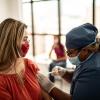
(Photos by Elisabeth Fall)
Geriatric Nursing Experts Share Knowledge, Ideas for the Future
On March 17, the UC San Francisco School of Nursing and the UCSF/John A. Hartford Center of Gerontological Nursing Excellence convened a group of clinicians, students, nurse researchers and health policy experts from the San Francisco Bay Area and beyond to discuss new ideas for delivering care to the nation’s elderly. During the conference, “Innovations in Geriatric Nursing Care,” several of the school’s top nurse researchers in geriatrics outlined recent and ongoing research into improving care of older adults. It was bookended by remarks about the future of the specialty from a pair of nationally renowned experts: Elizabeth A. Capezuti and John W. Rowe. The conference raised more than $17,000 for the Hartford Center’s Jeanie Schmit Kayser-Jones Student Scholarship Fund.
Promoting the Uptake of Evidence-Based Geriatric Care
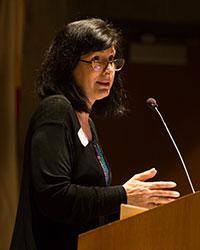 Elizabeth Capezuti Elizabeth Capezuti is the William Randolph Hearst Foundation Chair in Gerontology at Hunter College of the City University of New York and former director of Nurses Improving Care for Healthsystem Elders (NICHE). She gave an overview of the goals and successes of NICHE, a nurse-driven program based at the New York University College of Nursing that aims to improve the care of older adults by stimulating change in health care organizations.
Elizabeth Capezuti Elizabeth Capezuti is the William Randolph Hearst Foundation Chair in Gerontology at Hunter College of the City University of New York and former director of Nurses Improving Care for Healthsystem Elders (NICHE). She gave an overview of the goals and successes of NICHE, a nurse-driven program based at the New York University College of Nursing that aims to improve the care of older adults by stimulating change in health care organizations.
Capezuti emphasized that creating a positive geriatric nursing work environment is a system-level intervention that can promote safety and better outcomes at both the individual patient and organizational levels. NICHE research has identified several key elements of a positive work environment, including valuing older adults and staff autonomy, interdisciplinary collaboration and access to geriatric-specific resources.
“We teach people how to build geriatric capacity within an institution,” Capezuti said. NICHE emphasizes that sustainable change begins with increasing the geriatric competency of nurse clinicians and encouraging them to take an active role within interdisciplinary teams. These clinicians then serve as resources for others in an organization, from nursing assistants to physicians to administrators, and also for patients and family members. The aim is to eventually engage the entire organization and the community to improve care for geriatric patients in the hospital and beyond.
NICHE serves as a resource center for information on evidence-based geriatric care, and NICHE hospitals participate in collaborative research on best practices. “We see ourselves as a co-op, where everybody has to contribute, and so we all get much more out of it,” said Capezuti.
The program’s success can be measured in part by the increasing numbers of participating organizations – currently 500 (including UCSF) in North America – and its 95 percent to 100 percent retention rate. When the Medicare Innovations Collaborative looked at several well-known models of care for older patients, it concluded that, whichever model was used, NICHE was essential to building a strong foundation. Said Capezuti, “We’re building the science of how to get it done.”
No Smoker Left Behind: The Tobacco Industry Loves Older Smokers – Why Don’t We?
Janine Cataldo, assistant professor in the School’s Department of Physiological Nursing, outlined her research into tobacco companies’ and health care providers’ attitudes toward older smokers.
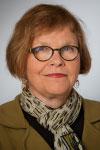 Janine Cataldo The tobacco industry has long waged an intense campaign to entice older people to take up or continue smoking, said Cataldo. She cited evidence from some of the millions of industry documents she and other researchers have uncovered. Cataldo provided some examples: advertisements aimed at creating a feeling of nostalgia among older people, promoting smoking as a choice rather than an addiction, targeting campaigns to demographically older areas and direct-mailing coupons to older smokers in the week pension checks are mailed.
Janine Cataldo The tobacco industry has long waged an intense campaign to entice older people to take up or continue smoking, said Cataldo. She cited evidence from some of the millions of industry documents she and other researchers have uncovered. Cataldo provided some examples: advertisements aimed at creating a feeling of nostalgia among older people, promoting smoking as a choice rather than an addiction, targeting campaigns to demographically older areas and direct-mailing coupons to older smokers in the week pension checks are mailed.
Cataldo also talked about the ways the industry has attempted to deter older smokers from quitting, including introducing misleading “low-tar” or “light” brands, and the promotion of alternative tobacco products (such as e-cigarettes or smokeless tobacco) as smoking-cessation aids. Cataldo’s research has confirmed the effectiveness of some of these campaigns and the difficulty anti-smoking public health messages have in reaching older smokers.
At the same time, said Cataldo, older smokers are less likely to be treated for their addiction, due in part to stigmatization and misperceptions among the public and health care providers. Common rationalizations used by clinicians (and smokers themselves) include the idea that it’s “too late” to help older smokers quit or that smoking is the “last pleasure” left to them. Cataldo recommended developing public health messages focusing on older smokers, and educating providers and the public about the benefits of quitting. She cited the US Public Health Service’s guidelines for treating smokers and outlined current evidence-based treatments, including tailored interventions combining behavioral modifications with pharmacological cessation aids, telephone counseling and proactive coaching.
Smoking should be treated as a chronic disease, she said, where relapse is to be expected: “Addiction is the disease; smoking is the symptom.”
Video Game-Based Activity: A Novel Approach to Physical Activity for Older Adults with Serious Mental Illness
Heather Leutwyler, assistant professor in the School’s Department of Physiological Nursing, presented her work, which has examined the barriers to physical activity among older adults with serious mental illness and which tested a video game-based intervention intended to get these older adults moving.
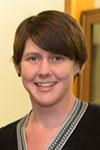 Heather Leutwyler She found that participants in her study of 30 older adults with schizophrenia across three mental-health treatment settings were, at baseline, sedentary for an average of 20 hours per day. Leutwyler wanted to know why. She found that among staff, the need to prioritize mental health and the challenges that come with treating the seriously mentally ill meant that physical activity often took a backseat. Institutional factors played a role as well: schedules and limited facilities meant there was little flexibility to work physical activity into clients’ days. For clients, mental illness itself was often a barrier. Depression reduced some clients’ desire to exercise, and the difficulty of managing symptoms of schizophrenia meant that clients were reluctant to go out on some days. Some also cited old age and poor physical condition as factors.
Heather Leutwyler She found that participants in her study of 30 older adults with schizophrenia across three mental-health treatment settings were, at baseline, sedentary for an average of 20 hours per day. Leutwyler wanted to know why. She found that among staff, the need to prioritize mental health and the challenges that come with treating the seriously mentally ill meant that physical activity often took a backseat. Institutional factors played a role as well: schedules and limited facilities meant there was little flexibility to work physical activity into clients’ days. For clients, mental illness itself was often a barrier. Depression reduced some clients’ desire to exercise, and the difficulty of managing symptoms of schizophrenia meant that clients were reluctant to go out on some days. Some also cited old age and poor physical condition as factors.
Clients also identified factors that facilitated physical activity, including knowledge that exercise made them feel better, pride in accomplishment and an increased feeling of belonging. Staff noted that rewards and meeting clients at their level – such as encouraging them to move even while seated – helped increase physical activity.
Leutwyler and her colleagues selected a video game-based intervention because video games have been shown to be effective in improving both physical activity levels and mental health and cognition in adults without serious mental illness. Moreover, because video games require no special attire and can be done in a safe environment with little need for other equipment, video games seemed a promising way to get clients moving in a variety of settings.
They used the Xbox Kinect system, and clients cycled through several different activities over the six-week study period; the research team adapted the activities to the physical limitations of some of the participants, including one who was confined to a wheelchair.
Leutwyler says that groups reported enjoying the activities and the atmosphere – and attendance was excellent. For clinicians interested in starting a video game-based program, Leutwyler suggested that video bowling would be a good activity to begin with, because of its relative ease. Clinicians should then experiment with different games to see what works and encourage staff to participate.
Vulnerable Populations at High Risk for Poor Care Transitions: Challenges and Innovation
“Older adults are often stuck in a revolving door of hospital admissions,” said Caroline Stephens, assistant professor in the School’s Department of Community Health Systems. She outlined her work examining this phenomenon, which disproportionately affects those with cognitive impairment, and discussed a potential intervention to help change the status quo.
Stephens and Mary Naylor, Marian S. Ware Professor in Gerontology and director of the NewCourtland Center for Transitions and Health at the University of Pennsylvania, looked at the care needs of hospitalized older adults with cognitive impairment. They found a variety of challenges, including difficulty with symptom management, as well as a need for respite and feelings of powerlessness and lack of confidence among caregivers. They also found a significant number of patients with previously unrecognized cognitive impairment. This finding was echoed in the work Stephens did for her doctoral thesis.
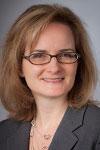 Caroline Stephens In other studies, Stephens found that nursing home residents with cognitive impairment are at 10 percent to 15 percent higher risk than other residents for potentially unnecessary emergency department (ED) visits. Two of the most significant risk factors for ED visits among nursing home residents with severe cognitive impairment are falls and the use of feeding tubes. The latter in particular, said Stephens, is potentially preventable, as many feeding tube placements may be inappropriate, with residents better served by oral feeding assistance.
Caroline Stephens In other studies, Stephens found that nursing home residents with cognitive impairment are at 10 percent to 15 percent higher risk than other residents for potentially unnecessary emergency department (ED) visits. Two of the most significant risk factors for ED visits among nursing home residents with severe cognitive impairment are falls and the use of feeding tubes. The latter in particular, said Stephens, is potentially preventable, as many feeding tube placements may be inappropriate, with residents better served by oral feeding assistance.
The Affordable Care Act brings new opportunities to change behavior and reform delivery systems. Hospitals, which are penalized for readmissions, and nursing homes that don’t want to be considered “bad facilities” will increasingly look for ways to reduce the number of “frequent fliers” that come through the ED doors, said Stephens. She has received a five-year career development award to create a “tele-ED” intervention, with the goal of improving timely assessment, care coordination and active engagement of caregivers at critical junctures of care transition.
Technology has the potential to reduce unnecessary ED visits by bringing primary care providers into nursing homes, said Stephens, but it can also provide validation for a caregiver’s assessment and allow family members to see what’s really going on with their loved ones. After initially conducting focus group interviews with multidisciplinary teams of providers and families of nursing home residents, Stephens will use the information gathered to develop an intervention for feasibility testing in several nursing homes.
Improving Adverse Event Communication in Nursing Homes
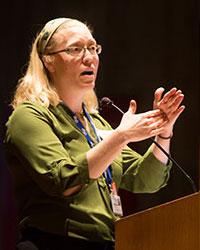 Laura Wagner Laura Wagner, assistant professor in the School’s Department of Community Health Systems, presented research on when and how adverse events in nursing homes are communicated, and discussed a current project investigating whether specialized training improves communication between nursing home staff and nursing home residents and families around adverse events.
Laura Wagner Laura Wagner, assistant professor in the School’s Department of Community Health Systems, presented research on when and how adverse events in nursing homes are communicated, and discussed a current project investigating whether specialized training improves communication between nursing home staff and nursing home residents and families around adverse events.
“Most of the research about adverse event communication has focused on doctors and hospitals,” said Wagner. “There is very little about nursing homes.” In her own study of nurses’ perceptions of adverse event reporting, Wagner found that nurses were most often the bearers of bad news, but that they were seldom trained in how to do it. She also found that the level of disclosure depended on a number of factors, including the severity of the incident – serious incidents were more likely to be disclosed, but with less detail or apology – and whether or not the nurse had experience in communicating adverse events. Barriers to full reporting included unclear definitions of adverse events, unclear responsibility, heavy workload and fear of punishment. Nurses cited a need for training and professional standards related to reporting, and for a culture that is more supportive of open communication.
Wagner is currently investigating a training model for adverse event communication in several nursing homes across California that aims to teach nurses about the importance of open communication and techniques for effective disclosure. The program teaches participants to complete four essential tasks after an adverse event: (1) attend to the resident (including charting the facts and preserving material for investigation), (2) address the nurse’s own emotions, (3) piece together what happened and (4) prepare for discussions with the resident and family. Nurses model and practice the discussions and learn to keep the acronym “ALEE” in mind: Anticipate and adjust, Listen for questions and concerns, Empathize and normalize reactions and offer to Explain what happened.
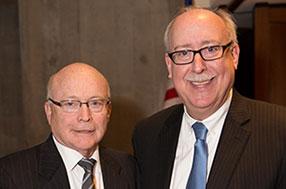 Jack Rowe and Dean David Vlahov Wagner concluded her presentation with actors playing the roles of a nursing home resident who had received a large overdose of insulin and a nurse who understands how to use the effective communication concepts.
Jack Rowe and Dean David Vlahov Wagner concluded her presentation with actors playing the roles of a nursing home resident who had received a large overdose of insulin and a nurse who understands how to use the effective communication concepts.
The Future of Geriatric Nursing
The final speaker was geriatrician John Rowe, professor in the Department of Health Policy and Management at the Columbia University Mailman School of Public Health, former CEO of Aetna and former president and CEO of Mount Sinai New York University Health. An edited transcript of Dr. Rowe’s discussion with UCSF’s Mary Louise Fleming is available here.



